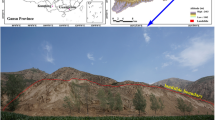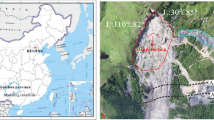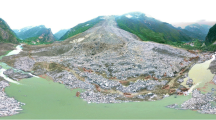Abstract
The Hongshiyan landslide was triggered by the Ms 6.5 Ludian earthquake in 2014 with more than 1200 × 104 m3 of rocks displaced. The landslide deposited entirely on the valley floor, and the landslide dam was eventually converted to a hydraulic structure for a permanent disposal. Despite the importance of material compositions to the slope stability and internal stability of a landslide dam, it was practically not viable and costly to explore the deeply buried materials in field. A 2D discrete element modeling (PFC2D code) was performed in this study to investigate the kinematic behavior of the Hongshiyan landslide. The study aims to provide insights into the material compositions of the landslide dam for future stability evaluations. The simulation results showed that for the landslide sitting in a deep V-shaped valley with constrained movement and steep slip surface gradient, the kinematic behavior was more sensitive to the bond strength (strength of intact rock mass) than the residual friction coefficient (residual friction of detached rock mass). The simulation results also suggested that the rock blocks were scarcely decomposed during sliding, as the material compositions of the landslide dam was primarily controlled by the development of joints and fissures prior to the failure.



(modified from KECL and Zhaotong Water Survey 2014)

(modified from KECL and Zhaotong Water Survey 2014)















Similar content being viewed by others
References
Avouac J-P, Meng L, Wei S, Wang T, Ampuero J-P (2015) Lower edge of locked Main Himalayan Thrust unzipped by the 2015 Gorkha earthquake. Nat Geosci 8:701–711
Casagli N, Ermini L (1999) Geomorphic analysis of landslide dams in the Northern Apennine. Jpn Geomorphol Union Trans 20(3):219–249
Casagli N, Ermini L, Rosati G (2003) Determining grain size distribution of the material composing landslide dams in the Northern Apennines: sampling and processing methods. Eng Geol 69(1):83–97
Chang KT, Lin ML, Chien CH (2012) The Hungtsaiping landslides: from ancient to recent. Landslides 9(2):205–214
Chang ZF, Chen XL, An XW, Cui JW (2016) Contributing factors to the failure of an unusually large landslide triggered by the 2014 Ludian, Yunnan, China, Ms = 6.5 earthquake. Nat Hazards Earth Syst Sci 16(2):497–507
Chen X, Zhou Q, Liu C (2015) Distribution pattern of coseismic landslides triggered by the 2014 Ludian, Yunnan, China Mw 6.1 earthquake: special controlling conditions of local topography. Landslides 12:1159–1168
Costa JE, Schuster RL (1988) The formation and failure of natural dams. Geol Soc Am Bull 100(7):1054–1068
Crosta GB, Chen H, Lee CF (2004) Replay of the 1987 Val Pola Landslide, Italian Alps. Geomorphology 60(1):127–146
Cundall PA (1971) A computer model for simulating progressive, large-scale movements in blocky rock systems. Proc Symp Int Soc Rock Mech 1:11–18
Cundall PA, Strack ODL (1979) A discrete numerical model for granular assemblies. Geotechnique 29(1):47–65
Deng Q, Gong L, Zhang L, Yuan R, Xue Y, Geng X, Hu S (2017) Simulating dynamic processes and hypermobility mechanisms of the Wenjiagou rock avalanche triggered by the 2008 Wenchuan earthquake using discrete element modelling. Bull Eng Geol Environ 76(3):923–936
Fang LH, Wu JP, Wang WL, Lv ZY, Wang CZ, Yang T, Zhong SJ (2014) Relocation of the aftershock sequence of the Ms 6.5 Ludian earthquake and its seismogenic structure. Seismol Geol 36(4):1173–1185
Havenith HB, Strom A, Calvetti F, Jongmans D (2003) Seismic triggering of landslides. Part B: simulation of dynamic failure processes. Nat Hazards Earth Syst Sci 3(6):663–682
Huang D, Cen D, Ma G, Huang R (2015) Step-path failure of rock slopes with intermittent joints. Landslides 12(5):911–926
Itasca (2015) PFC2D particle flow code in 2 dimensions. User’s guide. Minneapolis
Jibson RW (2011) Methods for assessing the stability of slopes during earthquakes—a retrospective. Eng Geol 122(1–2):43–50
Kaneda H, Nakata T, Tsutsumi H, Kondo H, Sugito N, Awata Y, Akhtar SS, Majid A, Khattak W, Awan AA (2008) Surface rupture of the 2005 Kashmir, Pakistan, earthquake and its active tectonic implications. Bull Seismol Soc Am 98(2):521–557
Kargel JS, Leonard GJ, Shugar DH, Haritashya UK, Bevington A, Fielding EJ, Fujita K, Geertsema M, Miles ES, Steiner J, Anderson E, Bajracharya S, Bawden GW, Breashears DF, Byers A, Collins B, Dhital MR, Donnellan A, Evans TL, Geai ML, Glasscoe MT, Green D, Gurung DR, Heijenk R, Hilborn A, Hudnut K, Huyck C, Immerzeel WW, Jiang L, Jibson R, Kääb A, Khanal NR, Kirschbaum D, Kraaijenbrink PDA, Lamsal D, Liu S, Lv M, McKinney D, Nahirnick NK, Nan Z, Ojha S, Olsenholler J, Painter TH, Pleasants M, Pratima KC, Qi Y, Raup BH, Regmi D, Rounce DR, Sakai A, Shangguan D, Shea JM, Shrestha AB, Shukla A, Stumm D, van der Kooij M, Voss K, Wang X, Weihs B, Wolfe D, Wu L, Yao X, Yoder MR, Young N (2016) Geomorphic and geologic controls of geohazards induced by Nepal’s 2015 Gorkha earthquake. Science 351(6269):aac8353
Kunming Engineering Corporation Limited (KECL), Zhaotong Investigation, Design & Research Institute of Water Conservancy & Hydropower (Zhaotong Water Survey) (2014) Feasibility study report of rehabilitation project for Hongshiyan dammed lake. (Report in Chinese)
Li X, He S, Luo Y, Wu Y (2012a) Simulation of the sliding process of Donghekou landslide triggered by the Wenchuan earthquake using a distinct element method. Environ Earth Sci 65(4):1049–1054
Li WC, Li HJ, Dai FC, Lee ML (2012b) Discrete element modeling of a rainfall-induced flowslide. Eng Geol 149–150:22–34
Li S-Q, Guo J-H, Yang X-Y, Li C-Z, Chang X-X (2015a) Causes for the collapse forming Hongshiyan quake lake. J Geol Hazards Environ Preserv 26(3):6–10 (in Chinese)
Li X, Xu X, Ran Y, Cui J, Xie Y, Xu F (2015b) Compound fault rupture in the 2014 Ms 6.5 Ludian, China, earthquake and significance to disaster mitigation. Seismol Res Lett 86(3):764–774
Liu C, Ge Y, Jia X, Guo Y (2016) Dynamic analysis the Hongshiyan collapse triggered by Ludian earthquake. J Disaster Prev Mitig Eng 36(4):601–608 (in Chinese)
Lo CM, Lin ML, Tang CL, Hu JC (2011) A kinematic model of the Hsiaolin landslide calibrated to the morphology of the landslide deposit. Eng Geol 123:22–39
Lu CY, Tang CL, Chan YC, Hu JC, Chi CC (2014) Forecasting landslide hazard by the 3D discrete element method: a case study of the unstable slope in the Lushan hot spring district, central Taiwan. Eng Geol 183(31):14–30
Lv Q, Liu Y, Yang Q (2017) Stability analysis of earthquake-induced rock slope based on back analysis of shear strength parameters of rock mass. Eng Geol 228(13):39–49
Molnar P, Tapponnier P (1975) Cenozoic tectonics of Asia: effects of a continental collision. Science 189(4201):419–426
Newmark NM (1965) Effects of Earthquakes on Dams and Embankments. Géotechnique 15(2):139–160
Okeke AC, Wang F, Mitani Y (2014) Influence of geotechnical properties on landslide dam failure due to internal erosion and piping. Landslide science for a safer geoenvironment. Springer, Berlin, pp 623–631
Owen LA, Kamp U, Khattak GA, Harp EL, Keefer DK, Bauer MA (2008) Landslides triggered by the 8 October 2005 Kashmir earthquake. Geomorphology 94(1–2):1–9
Pirulli M, Bristeau MO, Mangeney A, Scavia C (2007) The effect of the earth pressure coefficients on the runout of granular material. Environ Model Softwre 22(10):1437–1454
Poisel R, Preh A (2008) Modifications of PFC3D for rock mass fall modeling. In: Hart R, Detournay C, Cundall P (eds) Continuum and distinct element numerical modeling in geo-engineering - 2008. Itasca Consulting Group, Inc., Minneapolis
Potyondy DO, Cundall PA (2004) A bonded-particle model for rock. Int J Rock Mech Min Sci 41(8):1329–1364
Scaringi G, Fan X, Xu Q, Liu C, Ouyang C, Domènech G, Yang F, Dai L (2018) Some considerations on the use of numerical methods to simulate past landslides and possible new failures: the case of the recent Xinmo landslide (Sichuan, China). Landslides 15(7):1359–1375
Shi ZM, Xiong X, Peng M, Zhang LM, Xiong YF, Chen HX, Zhu Y (2017) Risk assessment and mitigation for the Hongshiyan landslide dam triggered by the 2014 Ludian earthquake in Yunnan, China. Landslides 14:269–285
Soga K, Alonso E, Yerro A, Kumar K, Bandara S (2016) Trends in large-deformation analysis of landslide mass movements with particular emphasis on the material point method. Géotechnique 66(3):248–273
Staron L (2008) Mobility of long-runout rock flows: a discrete numerical investigation. Geophys J Int 172(1):455–463
Swanson FJ, Oyagi N, Tominaga M (1986) Landslide dams in Japan. Landslide Dams: Processes, risk, and mitigation. pp 131–145
Tang C-L, Hu J-C, Lin M-L, Angelier J, Lu C-Y, Chan Y-C, Chu H-T (2009) The Tsaoling landslide triggered by the Chi-Chi earthquake, Taiwan: insights from a discrete element simulation. Eng Geol 106(1):1–19
Tapponnier P, Molnar P (1977) Active faulting and tectonics in China. J Geophys Res 82(20):2905–2930
Tapponnier P, Peltzer G, Armijo R (1986) On the mechanics of the collision between India and Asia. Geol Soc Lond Spec Publ 19(1):113–157
Tapponnier P, Xu ZQ, Roger F, Meyer B, Arnaud N, Wittlinger G, Yang JS (2001) Oblique stepwise rise and growth of the Tibet Plateau. Science 294(5547):1671–1677
Teufelsbauer H, Wang Y, Chiou MC, Wu W (2009) Flow-obstacle interaction in rapid granular avalanches: DEM simulation and comparison with experiment. Granul Matter 11(4):209–220
Tian Y, Xu C, Xu X, Chen J (2016) Detailed inventory mapping and spatial analyses to landslides induced by the 2013 Ms 6.6 Minxian earthquake of China. J Earth Sci 27(6):1016–1026
Wang L, Li S, Yu S, Du X, Deng G (2015) Key techniques for the emergency disposal of Hongshiyan landslide dam. J China Inst Water Resour Hydropower Res 13(4):284–289 (in Chinese)
Wasowski J, Keefer DK, Lee CT (2011) Toward the next generation of research on earthquake-induced landslides: current issues and future challenges. Eng Geol 122(1–2):1–8
Wu Jian-Hong, Lin Jeen-Shang, Chen Chao-Shi (2009) Dynamic discrete analysis of an earthquake-induced large-scale landslide. Int J Rock Mech Min Sci 46(2):397–407
Xu X, Wen X, Yu G, Chen G, Klinger Y, Hubbard J, Shaw J (2009) Coseismic reverse-and oblique-slip surface faulting generated by the 2008 Mw 7.9 Wenchuan earthquake, China. Geology 37(6):515–518
Xu X, Wen X, Han Z, Chen G, Li C, Zheng W, Zhang S, Ren Z, Xu C, Tan X, Wei Z, Wang M, Ren J, He Z, Liang M (2013) Lushan Ms 7.0 earthquake: a blind reserve-fault event. Chin Sci Bull 58(28–29):3437–3443
Xu C, Xu X, Shen L, Dou S, Wu S, Tian Y, Li X (2014a) Inventory of landslides triggered by the 2014 Ms 6.5 Ludian earthquake and its implications on several earthquake parameters. Seismol Geol 36(4):1186–1203
Xu C, Xu X, Shyu JBH, Zheng W, Min W (2014b) Landslides triggered by the 22 July 2013 Minxian-Zhangxian, China, Mw 5.9 earthquake: inventory compiling and spatial distribution analysis. J Asian Earth Sci 92:125–142
Xu C, Xu X, Yao X, Dai F (2014c) Three (nearly) complete inventories of landslides triggered by the May 12, 2008 Wenchuan Mw 7.9 earthquake of China and their spatial distribution statistical analysis. Landslides 11(3):441–461
Xu C, Xu X, Shyu JBH, Gao M, Tan X, Ran Y, Zheng W (2015a) Landslides triggered by the 20 April 2013 Lushan, China, Mw 6.6 earthquake from field investigations and preliminary analyses. Landslides 12(2):365–385
Xu C, Xu X, Shyu JBH (2015b) Database and spatial distribution of landslides triggered by the Lushan, China Mw 6.6 earthquake of 20 April 2013. Geomorphology 248:77–92
Xu X, Xu C, Li X, Yu G, Wu X, Jiang G (2015c) The Ludian Mw 6.2 earthquake: a minimum earthquake with primary surface ruptures in the eastern Tibetan Plateau. Seismol Res Lett 86(6):1622–1635
Xu C, Xu X, Tian Y, Shen L, Yao Q, Huang X, Ma J, Chen X, Ma S (2016a) Two comparable earthquakes produced greatly different coseismic landslides: the 2015 Gorkha, Nepal and 2008 Wenchuan, China events. J Earth Sci 27(6):1008–1015
Xu X, Han Z, Yang X, Zhang S, Yu G, Zhou B, Li F, Ma B, Chen G, Ran Y (2016b) Seismotectonic map in China and its adjacent regions. Seismological Press, Beijing
Xu X, Sun Q, Jin F, Soga K (2017) Three-dimensional simulation of the Hongshiyan landslide with the material point method. In: JTC1 workshop on advances in landslide understanding
Yuan RM, Tang CL, Hu JC, Xu X (2014) Mechanism of the Donghekou landslide triggered by the 2008 Wenchuan Earthquake revealed by discrete element modeling. Nat Hazards Earth Syst Sci 14(5):1195–1205
Zhang GW, Lei JS, Liang SS, Sun CQ (2014a) Relocations and focal mechanism solutions of the 3 August 2014 Ludian, Yunnan Ms 6.5 earthquake sequence. Chin J Geophys 57(9):3018–3027
Zhang Y, Xu LS, Chen YT, Liu RF (2014b) Rupture process of the 3 August 2014 Ludian, Yunnan, Mw 6.1 (Ms 6.5) earthquake. Chin J Geophys 57(9):3052–3059
Zhang M, Wu L, Zhang J, Li L (2019) The 2009 Jiweishan rock avalanche, Wulong, China: deposit characteristics and implications for its fragmentation. Landslides 16(5):893–906
Zhao T, Crosta GB (2018) On the dynamic fragmentation and lubrication of coseismic landslides. J Geophys Res Solid Earth 123:9914–9932
Zhou JW, Cui P, Fang H (2013a) Dynamic process analysis for the formation of Yangjiagou landslide-dammed lake triggered by the Wenchuan earthquake, China. Landslides 10(3):331–342
Zhou JW, Cui P, Yang XG (2013b) Dynamic process analysis for the initiation and movement of the Donghekou landslide-debris flow triggered by the Wenchuan earthquake. J Asian Earth Sci 76(S1):70–84
Zhou J, Peng Y, Ming H (2016) Landslides triggered by the 3 August 2014 Ludian earthquake in China: geological properties, geomorphologic characteristics and spatial distribution analysis. Geomat Nat Hazards Risk 7(4):1219–1241
Acknowledgements
The authors would like to acknowledge the financial supports from the National Key Research and Development Program of China (Grants 2018YFC1505004 and 2017YFC0404803), National Natural Science Foundation of China (Grant 41571012), and State Key Laboratory of Simulation and Regulation of Water Cycle in River Basin (SKL2018ZY09).
Author information
Authors and Affiliations
Corresponding author
Additional information
Publisher's Note
Springer Nature remains neutral with regard to jurisdictional claims in published maps and institutional affiliations.
Rights and permissions
About this article
Cite this article
Li, W.C., Deng, G., Cao, W. et al. Discrete element modeling of the Hongshiyan landslide triggered by the 2014 Ms 6.5 Ludian earthquake in Yunnan, China. Environ Earth Sci 78, 520 (2019). https://doi.org/10.1007/s12665-019-8438-2
Received:
Accepted:
Published:
DOI: https://doi.org/10.1007/s12665-019-8438-2




